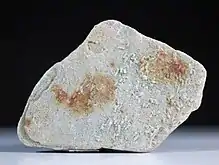Volborthella
Volborthella is an animal of uncertain classification, whose fossils pre-date 530 million years ago. It has been considered for a period a cephalopod.[6] However discoveries of more detailed fossils showed that Volborthella’s small, conical shell was not secreted but built from grains of the mineral silicon dioxide (silica), and that it was not divided into a series of compartments by septa as those of fossil shelled cephalopods and the living Nautilus are.[5] This illusion was a result of the laminated texture of the organisms' tests.[7] Therefore, Volborthella’s classification is now uncertain.[1] It has been speculated that it may in fact represent a sclerite of a larger organism, on the basis of one specimen;[7] however, it may be premature to accept this hypothesis, as the arrangement of sclerites producing this impression may have occurred by chance.[1] The Ordovician scleritome-bearing Curviconophorus,[8] as well as the Halwaxiids, lobopods and echinoderms, demonstrate the diversity of organisms which may produce a scleritome of this nature.[7] The related Campitius was originally suggested to be part of a radula rather than a scleritome,[9] but is now considered a synonym of Volborthella.[3]
| Volborthella | |
|---|---|
 | |
| Glauconitic sandstone with Volborthella fossils, from Stadtmuseum Berlin. | |
| Scientific classification | |
| Kingdom: | Animalia |
| Phylum: | †Agmata (?) |
| Family: | †Salterellidae |
| Genus: | †Volborthella Schmidt, 1888[2] |
| Species: | †V. tenuis |
| Binomial name | |
| †Volborthella tenuis | |
| Synonyms[3][4][5] | |
| |
Volborthella is widespread, and a useful biostratigraphic indicator;[7] it has been found in North America, Greenland, Spitsbergen, and northeastern Europe, and is restricted to Lower Cambrian rocks, appearing before the trilobites and co-existing with them for some time.[1]
Volborthella has been described as a 'failed attempt in mineralisation'; it constructed its wall by agglutinating grains of sediment, much like some foramanifera, and declined in conjunction with the origin of truly-biomineralising organisms. However, its similarity to Salterella, which contained embedded sediment grains in its mineralised wall, suggests a possible biological relationship - Salterella may have begun to mineralise its agglutinated wall. Some Volborthella specimens do show taphonomic hints that some form of lightly mineralised sheath may have enclosed its agglutinated shell.[1]
References
- Hagadorn, J.W.; Waggoner, B.M. (2002). "The Early Cambrian problematic fossil Volborthella: New insights from the Basin and Range". In Corsetti, F.A. (ed.). Proterozoic-Cambrian of the Great Basin and Beyond, Pacific Section SEPM Book 93 (PDF). SEPM (Society for Sedimentary Geology). pp. 135–150. Retrieved 2008-10-01.
- Schmidt, F. (1888). "Über eine neuentdeckte untercambrische Fauna in Estland". Mémoires de l'Académie Impériale des Sciences de Saint-Pétersbourg. 7. 36 (2): 1–27, 2 pls.
- Yochelson, Ellis L.; Kisselev, Gennadii N. (2003). "Early Cambrian Salterella and Volborthella (Phylum Agmata) re‐evaluated". Lethaia. 36 (1): 8–20. doi:10.1080/00241160310001254.
- Peel, John S. (2016). "Anatase and Hadimopanella selection by Salterella from the Kap Troedsson formation (Cambrian Series 2) of North Greenland". GFF. 139 (1): 70–74. doi:10.1080/11035897.2016.1227365.
- Lipps, J. H.; Sylvester, A. G. (1 March 1968). "The Enigmatic Cambrian Fossil Volborthella and Its Occurrence in California". Journal of Paleontology. 42 (2): 329–336. JSTOR 1302218.
- Clarke, M.R. (1985), "Main features of cephalopod evolution", in Wilbur, Karl M.; Clarke, M.R.; Trueman, E.R. (eds.), The Mollusca, 12. Paleontology and neontology of Cephalopods, New York: Academic Press, ISBN 0-12-728702-7
- Signor, P. W.; Ryan, D. A. (1993). "Lower Cambrian fossil Volborthella: the whole truth or just a piece of the beast?". Geology. 21 (9): 805. Bibcode:1993Geo....21..805S. doi:10.1130/0091-7613(1993)021<0805:LCFVTW>2.3.CO;2.
- Rudkin, D. M. (1998). "A new scleritomous metazoan from the Late Ordovician Georgian Bay Formation, southern Ontario". Canadian Journal of Earth Sciences. 35 (7): 827–831. Bibcode:1998CaJES..35..827R. doi:10.1139/cjes-35-7-827.
- Firby, J. B.; Durham, J. W. (1 November 1974). "Molluscan Radula from Earliest Cambrian". Journal of Paleontology. 48 (6): 1109–1338.